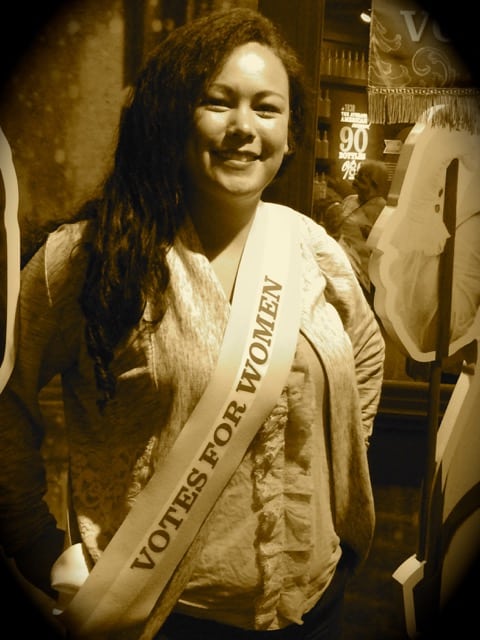Fortunately, we made it to the MOHAI (Museum of History and Industry) exhibit on “American Spirits: The Rise and Fall of Prohibition” when the tour came to Seattle. I learned more the impact women had on the enactment of the two amendments to the Constitution regarding prohibition: first the eighteenth amendment to prohibit it, and later the twenty-first amendment to repeal the earlier amendment and permit alcohol consumption once again.
I had known that the Suffrage Movement and the Prohibition Movement coincided and both were led by women, but I had not realized before how intertwined they were. Alcohol consumption in the early part of the twentieth century was much more extreme than it is today. The average drinker guzzled the equivalent of 90 bottles of 80-proof liquor a year (four shots a day), and its impact was felt largely by women. The women (and men) who pushed for prohibition used grisly statistics, emphasizing the deleterious effects of alcohol on family and on women. They asserted that men went into saloons, where women were not allowed, drank up their paychecks, came home affected by liquor, and wreaked havoc and even abuse on home life. Alcohol directly endangered women and their children, so the movement was led largely by women.
Women, however, were not naïve. They knew they were unlikely to persuade men to give up their alcohol and men made the laws. Men even held political meetings in saloons, where women were barred. Women had long wanted the vote, but realized that the time was ripe to renew the fight for suffrage. And so the two were wed. The eighteenth amendment banning alcohol took effect in 1920. The nineteenth amendment, granting women the right to vote, was ratified later that same year.
If anyone remembers stories of the history of the 20’s, they were swinging times and yet alcohol was forbidden for the entire decade and a few years beyond. Access to inebriating beverages, however, did not disappear. Some alcohol was legal. Sacramental wine was exempt and so was alcohol for “medicinal” purposes. The number of drugstores and pharmacies increased and women were able too purchase Lydia Pinkham’s Vegetable Compound, a 14-oz. bottle with 10.6% alcohol, for “female complaints.”
Illegal alcohol also abounded. Homemade brew became acceptable, as did the speakeasy, a place where, with the right password or nod of the head, one could be admitted to clubs filled with dancing and liquor. The irony was that women were allowed in the speakeasy, whereas they hadn’t been allowed in saloons. So, women gained the right to vote and the right to drink as well. Perhaps this is why women were as active in the movement to repeal prohibition as they had been in the efforts to secure its implementation. And perhaps, once they had gotten inside a drinking establishment, it was their tempering influence that kept alcohol consumption below the levels of the early part of the century, even after the amendment was repealed.

